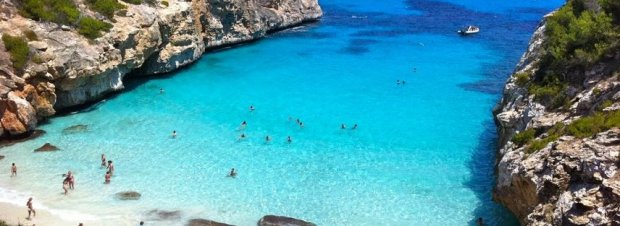Best beaches in Spain

Known to locals as the "Galician Caribbean, " the striking Illas Cies are a trio of pristine islands in Spain's northwest region of Galicia. The three islands lie partially exposed to the battering waves of the Atlantic Ocean, while their other sides face the Ria de Vigo, a tranquil estuary, and remains blissfully protected.
The Cies can be reached by ferry from the town of Vigo and visitors should head to the two main isles, Illa do Monte Ayudo and Illa do Faro. These islands are connected by Rodas Beach, a sliver of sand embracing a sheltered lagoon.
Rodas Beach is arguably Spain's prettiest, and its sparkling blue water and powder-white sands draw scores of tourists daily. Despite their popularity, the islands remain delightfully undeveloped - thanks to their designation as a nature preserve. Still, visitors will find a smattering of beach bars, a campground (reservations are required), a basic market and restaurant.
Insider Tip: Campers should bring their own tents and supplies. To continue preservation of the islands, the number of visitors allowed each day is limited; be sure to buy tickets for the 50-minute ferry ride in advance.
Perhaps you're familiar with the madhouse that is the Spanish island of Ibiza, one of the world's prettiest isles - and most notorious party destination. If you'd like to experience Ibiza's postcard-perfect setting without the ruckus, head to Formentera, Ibiza's equally pretty but far more tranquil neighbor.
The finest gem in Formentera's crown is undoubtedly Playa de Ses Illetes, a silky stretch of blinding white sand flanked by turquoise seas. Ses Illetes has gained a deserved reputation as the hangout for the fashion set. After a wild night on Ibiza, the sexy crowds don microscopic swimwear and head to Illetes to recover. The beach lacks fancy amenities like beach clubs, lounges or showers, but is home to a handful of beach bars and restaurants.
Insider Tip: When you're not baking in the sand, the spot to eat and be seen is Juan y Andrea, a multi-terraced seafood restaurant yards away from the sea.
Not every extraordinary beach needs to be an isolated oasis. Take for instance, La Concha in the town of San Sebastian. Its setting is so breathtaking in part because it is flanked by a striking cityscape made even more dramatic by San Sebastian's hilly topography.
La Concha's sprawling 130-foot-wide crescent of sand curves nearly 4, 500 feet around the sparkling Bay of La Concha, and is widely considered one of the world's top urban beaches. Its popularity means La Concha is perpetually crowded, though this party atmosphere can be part of its allure for some travelers.
To add to La Concha's striking setting, in the midst of the bay juts Santa Clara Island, a jagged and dramatic formation. When you've had enough sun and sea, stumble off the beach and into some of San Sebastian's main sites, including the bustling La Concha promenade, which surrounds the beach, or visit the nearby town hall and old town historic center.
Spain's Andalusian territory is home to some of Spain's most popular beaches, and most of them - like Marbella - are teeming with tourists. It seems almost an impossible feat to find an unblemished stretch of sand in this part of the Iberian Peninsula. Yet travelers willing to trek to the fishing village of Bolonia in Tarifa will be rewarded with one of Spain's last unblemished beaches, Playa de Bolonia.
The beach's 2.4 miles of shoreline curve around Bolonia Bay and except for an occasional stretch of rocky outcrop, there's little more than sand and surf to meet the eye. Though the beach feels legitimately wild in nature, there are amenities available, including beach umbrellas, restrooms and showers. Winds can be high along the playa, which makes the beach one of Spain's wind-surfing hubs.
Insider Tip: History buffs will be in heaven here; adjacent to the beach lie the ancient Roman ruins of Baelo Claudio, which were excavated in the 1970s.
The island of Mallorca is home to some of Spain's most striking natural landscapes including its most famous beach, Es Trenc. Though many of Spain's beaches are part of large resort complexes, Es Trenc stands alone and it is relatively isolated, backed by windswept sand dunes and a pine forest.
Insider Tip: Spanish beachgoers enjoy their beach amenities, and despite its relatively wild surroundings, Es Trenc offers beach chairs, umbrellas, lifeguards and bathrooms.
Source: www.travelchannel.com
Related posts:








